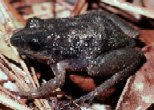| Southern chorus frog | |
|---|---|
 | |
| Scientific classification | |
| Kingdom: | Animalia |
| Phylum: | Chordata |
| Class: | Amphibia |
| Order: | Anura |
| Family: | Hylidae |
| Genus: | Pseudacris |
| Species: | P. nigrita |
| Binomial name | |
| Pseudacris nigrita (LeConte, 1825) | |
| Synonyms | |
Rana nigrita LeConte, 1825 | |
The southern chorus frog (Pseudacris nigrita) is a species of frog in the family Hylidae, endemic to the southeastern United States. Its natural habitats are temperate forests, temperate grassland, shrub-dominated wetlands, swamps, freshwater marshes, intermittent freshwater marshes, ponds, open excavations, seasonally flooded agricultural land, and canals and ditches. It is threatened by habitat loss.[ citation needed ]
